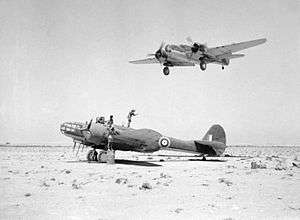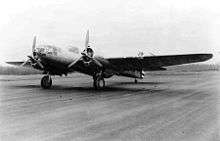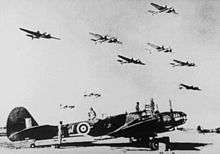Martin Maryland
The Martin Model 167 was an American-designed light bomber that first flew in 1939. It saw action in World War II with France and the United Kingdom, who named it the Maryland.
| Model 167 Maryland | |
|---|---|
 | |
| RAF Marylands c. 1941 | |
| Role | Light bomber |
| Manufacturer | Martin |
| First flight | 14 March 1939 |
| Introduction | 1940 |
| Retired | 1945 |
| Status | Out of service |
| Primary users | Royal Air Force South African Air Force French Air Force French Navy |
| Number built | 450 |
| Variants | Martin Baltimore |
Design and development
In response to a United States Army Air Corps light bomber requirement issued in 1938, the Glenn L. Martin Company produced its Model 167, which was given the official designation XA-22. Martin's design was a twin-engine all-metal monoplane, capable of around 310 mph (500 km/h) with a crew of three. The XA-22 was not adopted for operational service in the U.S., as the contract was won by the Douglas DB-7, which became the A-20 Havoc, but Martin received foreign orders, and about 450 of these fast, twin-engined bombers were built.
The prototype Model 167W was powered by twin-row Pratt & Whitney R-1830-37 Twin Wasp engines, which were replaced in French production aircraft by single-row nine-cylinder Wright R-1820 Cyclone engines, although the Twin Wasps were then restored for the British Maryland. All versions of the Model 167 were armed with six machine guns, four fixed guns in the wings (mainly for ground-attack), one dorsal gun and one ventral gun. In the prototype, these guns were all 0.30 in Browning machine guns. The dorsal gun was mounted in a fully retractable turret. The French aircraft used license-built Belgian Fabrique Nationale FN-Brownings, and used a lighter semi-retractable dorsal turret. The weight saved helped to increase the top speed to 288 mph (463 km/h).

The Model 167 was a fairly typical twin-engined bomber of the period. The most unusual feature of the Model 167 was the very narrow fuselage, although it was shared with a number of late prewar contemporaries. The crew of three was carried in two isolated compartments: the bombardier sat in the nose below the pilot and the gunner was in the mid-upper twin-machine gun turret in a separate rear compartment, isolated by a bulkhead.
Glenn L. Martin doubled the size of the Baltimore factory, and built all 115 aircraft in six months, but they were then prevented from delivering them by a US government arms embargo. Despite this the French placed an order for an additional 100 aircraft. The embargo was lifted in October 1939, and the 115 aircraft from the first order were delivered by late November 1939. Deliveries then slowed, and only 25 of the second batch reached France before the Armistice of 22 June 1940.
Operational history
French service

Facing a massive German arms buildup and desperate for modern aircraft, the French Air Force purchased U.S. aircraft of numerous types in the late 1930s. Martin received an order for more than 200 167 Fs which incorporated French equipment such as metric instruments. French officials expected deliveries to begin in January 1939 but the type, locally called the Glenn Martin 167 A-3 entered service only in early 1940.
Because of the U.S. embargo on arms exports after the beginning of the war, many aircraft were impounded for two months before being shipped to Europe. When the Battle of France began, there were only four Groupes de bombardement (bomber squadrons) equipped. The Glenns were quickly sent to the front lines where they performed well with their adequate speed and excellent manoeuvrability for an aircraft in this class.[1] In about 400 sorties, they suffered a 4 per cent loss rate, much better than the 16 per cent endured by LeO 451 crews against similar targets.
Immediately before the June 1940 Armistice, units flying the Glenn Martin 167 were evacuated to French North Africa to avoid capture by the Germans. One of them landed in Spain and was interned, being tested by the Spanish Air Force. Some examples were transferred to the Aéronautique Navale. During Vichy rule of the French empire, French Martins bombed British Commonwealth forces, most notably during the Syria-Lebanon campaign of 1941.[2] As French North Africa got back in the Allied camp in 1943, M.167s were replaced with more modern Allied types, including the Martin B-26 Marauder. Approximately 215 Martin 167s were delivered to France.
British service

Just before the Franco-German Armistice, the remaining 75 aircraft on the French order were signed over to the United Kingdom; 32 Marylands had been completed to French specifications and were converted to British requirements in the UK. Engines were changed from the Cyclone 9 to the Pratt and Whitney Twin Wasp and various weapons and instruments were replaced. The last 43 of the order were completed as required by Glenn Martin. All these aircraft became the Maryland Mk.I. A further 150 aircraft had been ordered directly by Britain with two-speed superchargers on their Twin Wasps as the Maryland Mk.II.[3]
Many of the aircraft were shipped to Egypt and Malta in time for the 1941 fighting there. The RAF used the aircraft mainly for photo-reconnaissance operations in North and East Africa, being faster than the Bristol Blenheim. A Maryland bomber photographed the Italian fleet before and after the Battle of Taranto on 11 November 1940.[4] The pilot, Adrian Warburton, scored his five confirmed kills with the Maryland's forward-firing guns.
Three Maryland Mk.Is were transferred to the British Fleet Air Arm[5] and were mainly used for target towing duties.[6] On 22 May 1941, a Maryland of 771 Naval Air Squadron based at Hatston in the Orkney Islands, reported that the German battleship Bismarck had left Bergen, confirming that she was breaking out into the Atlantic.[7]
Operators
- Armée de l'Air
- Aéronavale
- Free French Air Force
- Vichy French Air Force
- South African Air Force
- No. 12 Squadron SAAF
- No. 16 Squadron SAAF
- No. 21 Squadron SAAF
- No. 24 Squadron SAAF
Specifications (Maryland Mk I)
General characteristics
- Crew: three (pilot, navigator/bomb aimer/gunner and radio operator/gunner)
- Length: 46 ft 8 in (14.2 m)
- Wingspan: 61 ft 4 in (18.7 m)
- Height: 16 ft 3 in (5.0 m)
- Wing area: 537 sq ft (49.9 m2)
- Empty weight: 10,586 lb (4,802 kg)
- Gross weight: 15,297 lb (6,939 kg)
- Max takeoff weight: 16,809 lb (7,624 kg)
- Fuel capacity: 514 imperial gallons (2,336 litres)
- Powerplant: 2 × Pratt & Whitney R-1830-S1C3-G "Twin Wasp" radial engine, 1,050 hp (783 kW) each
- Propellers: 3-bladed Hamilton Standard 3T50 constant-speed metal propellers, 10 ft 11 in (3.3 m) diameter
Performance
- Maximum speed: 304 mph (489 km/h, 264 kn) at 13,000 ft (3,962 m)
- Cruise speed: 248 mph (399 km/h, 216 kn)
- Range: 1,300 mi (2,100 km, 1,100 nmi)
- Service ceiling: 29,500 ft (8,991 m)
- Rate of climb: 2,400 ft/min (12 m/s)
- Wing loading: 28.5 lb/sq ft (139.1 kg/m2)
- Power/mass: 0.157 hp/lb (259 W/kg)
Armament
- Guns: 4 x .303 (7.7 mm) Browning Mk II machine guns in outer wings with 750 rpg, 1 × .303 in (7.7 mm) Vickers K machine gun in dorsal and ventral step positions each with 5 x 97-round magazines
- Bombs: 2,000 lb (907 kg) internally; (Usually 4 x 500 lb (227 kg) bombs)
See also
Related development
Aircraft of comparable role, configuration and era
Related lists
References
- Notes
- "The Martin Maryland goes to war, 23 October 1941." :Fr Archived 5 October 2012 at the Wayback Machine Maryland Aviation Museum. Retrieved: 2 July 2012/
- Documented in the memoirs of Roald Dahl and John Masters (The Road Past Mandalay) (1961.)
- Military History Encyclopedia on the Web: Weapons - Martin Maryland
- Bishop 2004, pp. 90–91.
- Joseph F. Baugher: US Attack Aircraft - Martin Maryland
- Mondey 2006, p. 175.
- Shores 1971, p. 220.
- Bibliography
- Bishop, Chris. The Encyclopedia of 20th Century Air Warfare. London: Amber Books Ltd, 2004. ISBN 1-904687-26-1.
- Cuny, Jean. "Glenn Martin 167 in French Service". Journal of American Aviation Historical Society. Volume 10, No. 1, Spring 1965.
- Mondey, David. American Aircraft of World War II (Hamlyn Concise Guide). London: Bounty Books, 2006. ISBN 978-0-7537-1461-4.
- Munson, Kenneth. Fighters and Bombers of World War II: 1939–45. London: Blandford Press Ltd, 1969. ISBN 0-9637110-4-0.
- Shores, Christopher F. (1971). Martin Maryland and Baltimore Variants. Aircraft in Profile. XI. Windsor: Profile Publications. pp. 217–230. OCLC 223756773.CS1 maint: ref=harv (link)
- Wagner, Ray. "American Combat Planes, Third Enlarged Edition". New York: Doubleday & Company, 1982, pp. 178–179. ISBN 978-0-3851-3120-9.
External links
| Wikimedia Commons has media related to Martin Maryland. |
- Fleet Air Arm Archive article
- "The French Martin" a 1940 Flight article